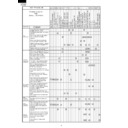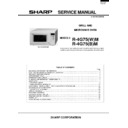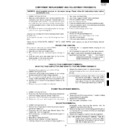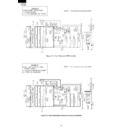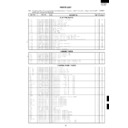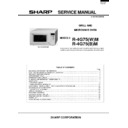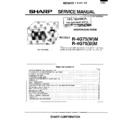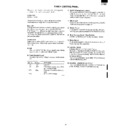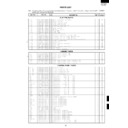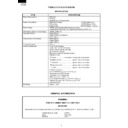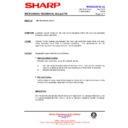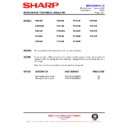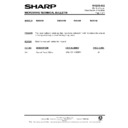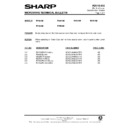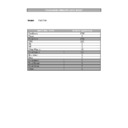Read Sharp R-4G75M (serv.man3) Service Manual online
8
R-4G75(W)M
R-4G75(B)M
R-4G75(B)M
Fuse 13A blows when power cord is
plugged into wall outlet.
plugged into wall outlet.
Fuse M8A blows when the door is
opened.
opened.
Oven lamp does not light when
door is opened. (Display
appears.)
door is opened. (Display
appears.)
Home fuse blows when power
cord is plugged into wall outlet.
cord is plugged into wall outlet.
“88:88” does not appear in display
when power cord is plugged into
wall outlet.
when power cord is plugged into
wall outlet.
Display does not operate properly
when STOP pad is touched.
when STOP pad is touched.
Oven does not start when START
pad is touched. (Display appears.)
pad is touched. (Display appears.)
Oven lamp does not light.
(Turntable motor operates.)
(Turntable motor operates.)
Fan motor does not operate.
(Oven lamp light.)
(Oven lamp light.)
Turntable motor assembly does
not operate. (Oven lamp light.)
not operate. (Oven lamp light.)
Oven or electrical parts do not
stop when cooking time is 0 or
STOP pad is touched.
stop when cooking time is 0 or
STOP pad is touched.
Oven goes into cook cycle but
shuts down before end of cooking
cycle.
shuts down before end of cooking
cycle.
Oven stops as soon as the
START pad is touched. (Except
for Grill Cooking)
START pad is touched. (Except
for Grill Cooking)
Oven seems to be operating but
little or no heat is produced in
oven load. (Microwave power
level is set at ”HIGH”)
little or no heat is produced in
oven load. (Microwave power
level is set at ”HIGH”)
Oven does not operate properly
during the variable cooking
condition except ”HIGH” cooking
condition. (Oven operates
properly at HIGH)
during the variable cooking
condition except ”HIGH” cooking
condition. (Oven operates
properly at HIGH)
Oven goes into cook cycle but
shuts down before end of cooking
cycle.
Oven stops as soon as start pad
is touched.
shuts down before end of cooking
cycle.
Oven stops as soon as start pad
is touched.
Grill Heating element does not
operate.
operate.
Oven seems to be operating but
little or no heat is produced in
oven load. (Microwave power
does not seem to be generated
properly)
little or no heat is produced in
oven load. (Microwave power
does not seem to be generated
properly)
Grill Heating element does not
operate.
operate.
AH. sensor does not end during
Sensor cooking condition. (Oven
does not shut off when a cup of
water is boiling by Sensor
Cooking.)
Sensor cooking condition. (Oven
does not shut off when a cup of
water is boiling by Sensor
Cooking.)
Oven stops at 16 sec. after
starting
starting
TEST PROCEDURE
POSSIBLE CAUSE
AND
DEFECTIVE PARTS
PROBLEM
A B C D E E E E F F F G H
I J K K L
M O O O N P Q
CONDITION
MAGNETRON
POWER TRANSFORMER
H.V. RECTIFIER ASSEMBLY
H.V. CAPACITOR
PRIMARY LATCH SWITCH
2ND. LATCH SWITCH
MONITOR SWITCH
STOP SWITCH
THERMAL CUT-OUT 125˚C
THERMAL CUT-OUT 150˚C
THERMAL CUT-OUT 160˚C
FUSE 13A
FUSE M8A
NOISE FILTER
MONITOR RESISTOR
FAN MOTOR
TURNTABLE MOTOR
GRILL HEATING ELEMENTS
POWER SUPPLY CORD
OVEN LAMP OR SOCKET
SHORTED WIRE HARNESS
OPENED WIRE HARNESS
MISADJUSTMENT SWITCHES
TOUCH CONTROL PANEL
RELAY RY-1
RELAY RY-2
RELAY RY-3
KEY UNIT
FOIL PATTERN ON PWB.
AH. SENSOR ASSEMBLY
GRILL
COOKING
CONDITION
COOKING
CONDITION
DUAL
COOKING
CONDITION
COOKING
CONDITION
SENSOR
COOKING
CONDITION
COOKING
CONDITION
MICROWAVE
COOKING
CONDITION
COOKING
CONDITION
COOKING
CONDITION
(COMMON)
CONDITION
(COMMON)
OFF
CONDITION
CONDITION
9
R-4G75(W)M
R-4G75(B)M
R-4G75(B)M
TEST PROCEDURES
PROCEDURE
LETTER
COMPONENT TEST
A
MAGNETRON TEST
NEVER TOUCH ANY PART IN THE CIRCUIT WITH YOUR HAND OR AN INSULATED TOOL WHILE
THE OVEN IS IN OPERATION.
THE OVEN IS IN OPERATION.
Measuring condition:
1. Container
1. Container
The water container must be a cylindrical borosilicate glass vessel having a maximum material
thickness of 3 mm and an outside diameter of approximately 190 mm.
thickness of 3 mm and an outside diameter of approximately 190 mm.
2. Temperature of the oven and vessel
The oven and the empty vessel are at ambient temperature prior to the start of the test.
3. Temperature of the water
The initial temperature of the water is (10
±
2)
°
C.
4. Select the initial and final water temperature so that the maximum difference between the final water
temperature and the ambient temperature is 5K.
5. Select stirring devices and measuring instruments in order to minimize addition or removal of heat.
6. The graduation of the thermometer must be scaled by 0.1
6. The graduation of the thermometer must be scaled by 0.1
°
C at minimum and an accurate thermometer.
7. The water load must be (1000
±
5) g.
8. “t” is measured while the microwave generator is operating at full power. Magnetron filament heat-up
time is not included.
NOTE: The operation time of the microwave oven is “t + 3” sec. 3 sec. is magnetron filament heat-up time.
Measuring method:
1. Measure the initial temperature of the water before the water is added to the vessel.
1. Measure the initial temperature of the water before the water is added to the vessel.
(Example: The initial temperature T1 = 11
°
C)
2. Add the 1 litre water to the vessel.
3. Place the load on the centre of the shelf.
4. Operate the microwave oven at HIGH for the temperature of the water rises by a value
3. Place the load on the centre of the shelf.
4. Operate the microwave oven at HIGH for the temperature of the water rises by a value
∆
T of
(10
±
2) K.
5. Stir the water to equalize temperature throughout the vessel.
6. Measure the final water temperature. (Example: The final temperature T2 = 21
°
C)
7. Calculate the microwave power output P in watts from above formula.
The formula is as follows;
P x t / 4.187 = V x
∆
T
P (W) = 4.187 x V x
∆
T / t
Our condition for water load is as follows:
Room temperature..............around 20
°
C
Power supply Voltage.........Rated voltage
Water load.........1000 g Initial temperature...........10
±
2
°
C
Heating time ...42+3=45 sec.
P = 100 x
∆
T
CARRY OUT 3D CHECK
Isolate the magnetron from the high voltage circuit by removing all leads connected to filament terminal.
To test for an open circuit filament use an ohmmeter to make a continuity test between the magnetron
filament terminals, the meter should show a reading of less than 1 ohm.
filament terminals, the meter should show a reading of less than 1 ohm.
To test for short filament to anode condition, connect ohmmeter between one of the filament terminals and
the case of the magnetron (ground). This test should be indicated an infinite resistance. If a low or zero
resistance reading is obtained then the magnetron should be replaced.
the case of the magnetron (ground). This test should be indicated an infinite resistance. If a low or zero
resistance reading is obtained then the magnetron should be replaced.
MICROWAVE OUTPUT POWER (IEC-705-1988)
The following test procedure should be carried out with the microwave oven in a fully assembled condition
(outer case fitted). Microwave output power from the magnetron can be measured by way of IEC 705, i.e.
it can be measured by using water load how much it can be absorbed by the water load. To measure the
microwave output power in the microwave oven, the relation of calorie and watt is used. When P(W) heating
works for t(second), approximately P x t/4.187 calorie is generated. On the other hand, if the temperature
of the water with V(ml) rises
The following test procedure should be carried out with the microwave oven in a fully assembled condition
(outer case fitted). Microwave output power from the magnetron can be measured by way of IEC 705, i.e.
it can be measured by using water load how much it can be absorbed by the water load. To measure the
microwave output power in the microwave oven, the relation of calorie and watt is used. When P(W) heating
works for t(second), approximately P x t/4.187 calorie is generated. On the other hand, if the temperature
of the water with V(ml) rises
∆
T (
°
C) during this microwave heating period, the calorie of the water is V x
∆
T.
10
R-4G75(W)M
R-4G75(B)M
R-4G75(B)M
TEST PROCEDURES (CONT'D)
PROCEDURE
LETTER
COMPONENT TEST
Initial temperature ......................................................................................................... T1 = 11
°
C
Temperature after (42 + 3) = 45 sec. ............................................................................ T2 = 21
°
C
Temperature difference Cold-Warm ............................................................................
∆
T1 = 10
°
C
Measured output power
The equation is “P = 100 x
The equation is “P = 100 x
∆
T” ........................................... P = 100 x 10
°
C = 1000 Watts Approx.
JUDGMENT: The measured output power should be at least
±
15 % of the rated output power.
CAUTION: 1
°
C CORRESPONDS TO 100 WATTS. REPEAT MEASUREMENT IF THE POWER IS
INSUFFICIENT.
Heat up for 45sec.
1000g
1000g
1000g
T1˚C
T2˚C
B
POWER TRANSFORMER TEST
WARNING: High voltages and large currents are present at the secondary winding and
filament winding of the power transformer. It is very dangerous to work near
this part when the oven is on. NEVER make any voltage measurements of the
high-voltage circuits, including the magnetron filament.
this part when the oven is on. NEVER make any voltage measurements of the
high-voltage circuits, including the magnetron filament.
CARRY OUT 3D CHECKS
Disconnect the leads to the primary winding of the power transformer. Disconnect the filament and
secondary winding connections from the rest of the HV circuitry. Using an ohmmeter, set on a low range,
it is possible to check the continuity of all three windings. The following readings should be obtained:-
secondary winding connections from the rest of the HV circuitry. Using an ohmmeter, set on a low range,
it is possible to check the continuity of all three windings. The following readings should be obtained:-
a. Primary winding ............ 1.3 ohms approximately
b. Secondary winding ....... 82 ohms approximately
c. Filament winding ........... less than 1 ohm
b. Secondary winding ....... 82 ohms approximately
c. Filament winding ........... less than 1 ohm
If the reading obtained are not stated above, then the power transformer is probably faulty and should be
replaced.
replaced.
CARRY OUT 4R CHECKS
C
HIGH VOLTAGE RECTIFIER ASSEMBLY TEST
HIGH VOLTAGE RECTIFIER TEST
CARRY OUT 3D CHECKS.
Isolate the high voltage rectifier assembly from the HV circuit. The high voltage rectifier can be tested using
an ohmmeter set to its highest range. Connect the ohmmeter across the terminal B + C of the high voltage
rectifier and note the reading obtained. Reverse the meter leads and note this second reading. The normal
resistance is infinite in one direction and more than 100 k
an ohmmeter set to its highest range. Connect the ohmmeter across the terminal B + C of the high voltage
rectifier and note the reading obtained. Reverse the meter leads and note this second reading. The normal
resistance is infinite in one direction and more than 100 k
Ω
in the other direction.
CARRY OUT 4R CHECKS
ASYMMETRIC RECTIFIER TEST
CARRY OUT 3D CHECKS.
A
B
C
D2
D1
ASYMMETRIC
RECTIFIER
RECTIFIER
HIGH VOLTAGE RECTIFIER
11
R-4G75(W)M
R-4G75(B)M
R-4G75(B)M
TEST PROCEDURES (CONT'D)
PROCEDURE
LETTER
COMPONENT TEST
Isolate the high voltage rectifier assembly from the HV circuit. The asymmetric rectifier can be tested using
an ohmmeter set to its highest range. Connect the ohmmeter across the terminals A + B of the asymmetric
rectifier and note the reading obtained. Reverse the meter leads and note this second reading. If an open
circuit is indicated in both directions then the asymmetric rectifier is good. If an asymmetric rectifier is
shorted in either direction, then the asymmetric rectifier is probably faulty and must be replaced with the
high voltage rectifier. When the asymmetric rectifier is defective, check whether magnetron, high voltage
rectifier, high voltage wire or filament winding of the power transformer is shorted.
an ohmmeter set to its highest range. Connect the ohmmeter across the terminals A + B of the asymmetric
rectifier and note the reading obtained. Reverse the meter leads and note this second reading. If an open
circuit is indicated in both directions then the asymmetric rectifier is good. If an asymmetric rectifier is
shorted in either direction, then the asymmetric rectifier is probably faulty and must be replaced with the
high voltage rectifier. When the asymmetric rectifier is defective, check whether magnetron, high voltage
rectifier, high voltage wire or filament winding of the power transformer is shorted.
CARRY OUT 4R CHECKS
NOTE: FOR MEASUREMENT OF THE RESISTANCE OF THE RECTIFIER, THE BATTERIES OF THE
MEASURING INSTRUMENT MUST HAVE A VOLTAGE AT LEAST 6 VOLTS, BECAUSE
OTHERWISE AN INFINITE RESISTANCE MIGHT BE SHOWN IN BOTH DIRECTIONS.
OTHERWISE AN INFINITE RESISTANCE MIGHT BE SHOWN IN BOTH DIRECTIONS.
D
HIGH VOLTAGE CAPACITOR TEST
CARRY OUT 3D CHECKS
A. Isolate the high voltage capacitor from the circuit.
B. Continuity check must be carried out with measuring instrument which is set to the highest resistance
B. Continuity check must be carried out with measuring instrument which is set to the highest resistance
range.
C. A normal capacitor shows continuity for a short time (kick) and then a resistance of about 10 M
Ω
after
it has been charged.
D. A short-circuited capacitor shows continuity all the time.
E. An open capacitor constantly shows a resistance about 10 M
E. An open capacitor constantly shows a resistance about 10 M
Ω
because of its internal 10 M
Ω
resistance.
F. When the internal wire is opened in the high voltage capacitor, the capacitor shows an infinite
resistance.
G. The resistance across all the terminals and the chassis must be infinite when the capacitor is normal.
If incorrect readings are obtained, the high voltage capacitor must be replaced.
If incorrect readings are obtained, the high voltage capacitor must be replaced.
CARRY OUT 4R CHECKS
E
SWITCH TEST
CARRY OUT 3D CHECKS
Isolate the switch to be tested and using an ohmmeter check between the terminals as described in the
following table.
following table.
COM;
Common terminal
NO;
Normally open terminal
NC;
Normally close terminal
Table: Terminal Connection of Switch
Plunger Operation
COM to NO
COM to NC
Released
Open circuit
Short circuit
Depressed
Short circuit
Open Circuit
If incorrect readings are obtained, make the necessary switch adjustment or replace the switch.
CARRY OUT 4R CHECKS.
F
TERMINAL CUT OUT TEST
CARRY OUT 3D CHECKS
Disconnect the leads from the terminals of the thermal cut-out. Then using an ohmmeter, make a continuity
test across the two terminals as described in the below.
test across the two terminals as described in the below.
CARRY OUT 4R CHECKS
Table: Thermal Cut-out Test
PARTS NAME
THERMAL CUT-OUT
THERMAL CUT-OUT
THERMAL CUT-OUT
Condition
125
°
C (MAG)
150
°
C (GRILL)
160
°
C (OVEN)
Temperature of ”ON” condition
This is not resetable type
130
°
C
This is not resetable type
(closed circuit)
Temperature of ”OFF” condition
Above 125
°
C
Above 150
°
C
Above 160
°
C
(open circuit)
Indication of ohmmeter (When room
Closed circuit
Closed circuit
Closed circuit
temperature is approx. 20
°
C.)
If incorrect readings are obtained replace the thermal cut-out.

